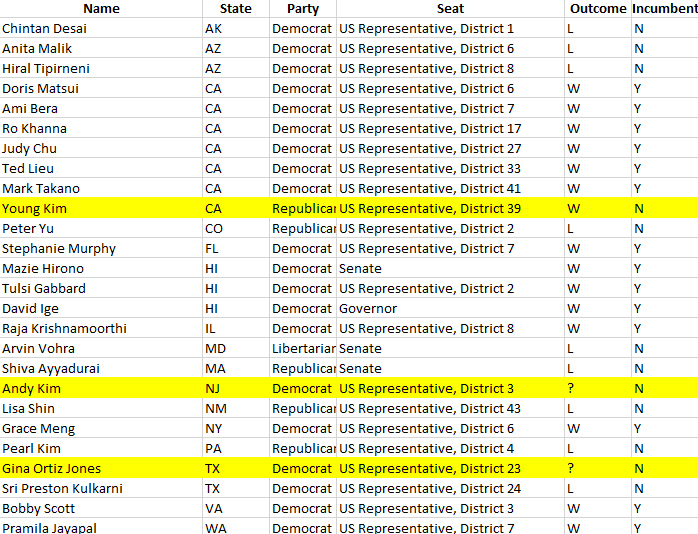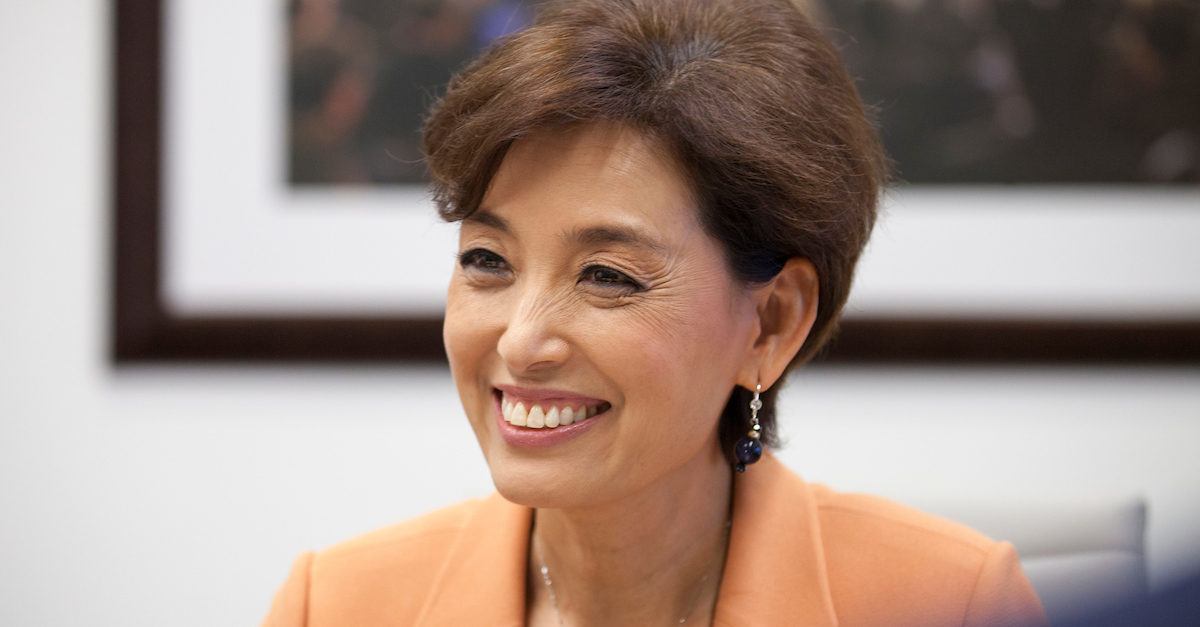Editor’s Note: Since the writing of this post, it has become clear that Young Kim’s race has not yet been called due to a number of outstanding ballots still to be counted; however she leads by a 5-point margin in her race. This post will be updated if the outcome of her election changes.
The dust settled on Tuesday, November 6th, 2018 with a consequential power shift for Democrats: the House of Representatives flipped to a substantial Democratic majority after Democratic candidates were able to unseat or overcome Republican opponents in several states across the nation; and Democrats also picked up 7 governorships, rendering the new gubernatorial balance of power a near-even split with Republicans.
Tuesday night saw the election of several historic firsts, including the first Native women to be elected to Congress, the first Muslim women to be elected to Congress, and the election of the first openly-gay state governor.
The Asian American community also saw its own historic firsts. Just shy of the number of Asian Americans or Pacific Islander (AAPI) candidates who competed for a congressional or gubernatorial seat in 2016, 26 AAPI candidates were vying in a federal or gubernatorial race on Tuesday night. All AAPIs running as incumbents, including thirteen members of the Congressional Asian Pacific American Caucus (CAPAC) were re-elected — most by sweeping margins. In particular, Hawaii’s Senator Mazie Hirono — who has dominated headlines recently for her fiery commentary during the Kavanaugh hearings — won more than 70% of the votes in her district, which serve as a clear mandate for more prominent feminist rhetoric on the Hill after more than a year of headlines dominated by the erosion of women’s rights.
In California’s 39th District which represents California’s northern Orange County — a county that is 21% Asian American — Republican Young Kim became the first Korean American woman elected to Congress. The Asian American community is also poised to potentially pick up two other seats in Congress: Democrat Andy Kim leads by a narrow margin for New Jersey’s 3rd District, and Kim has declared himself the winner over Republican incumbent Tom MacArthur. Meanwhile, in Texas, Gina Ortiz Jones trails by less than 700 votes behind Republican incumbent Will Hurd to represent the 23rd District. Texas has unofficially called the election for Hurd, but Ortiz Jones — who, if elected, would be the first Filipinx American woman to serve in Congress — is likely to demand a recount.

And yet, in an election year touted as a watershed moment for women and non-white candidates and when Asian American voters shifted farther to the left than any other racial group, it is notable that fewer Asian American or Pacific Islander candidates were on the ballot on Tuesday for Congressional seats than in 2016.
I can only wonder if this is a sign that both parties — but particularly the Democratic party –has still to adequately invest in Asian American voters and candidates.
Both the Democratic Party and the Republican Party have repeatedly failed in past years to engage Asian American voters. AAPIData has reported that more than two-thirds of Asian American voters receive no contact by Democrats or Republicans during the election season. This year, the Democratic Party expressed a commitment to improve voter outreach to Asian Americans; but it’s unclear if that commitment translated to meaningful investment into the Asian American electorate by individual Democratic campaigns.
As evidence for how little some Democratic campaigns invest in speaking to Asian American voters, California’s new governor-elect Gavin Newsom, who will be charged with running a state that is home to several of the nation’s largest populations of Asian Americans, chose to skip the first Asian American-facing governor’s debate in the state’s history, which took place earlier this year.
In Orange County, California where I live, two districts were viewed as battleground races for Democrats seeking to retake the House: the race to elect Gil Cisneros in CA-39, and the effort to elect Katie Porter in CA-45. Despite several news stories underscoring the importance of appealing to Asian American voters in this county, it is unclear that either the Porter or Cisneros campaigns effectively outreached to the county’s Asian American voters. While Cisneros’ campaign is the only high-profile campaign to be managed by an Asian American campaign manager, and Cisneros’ campaign invested in bilingual staffers to do in-language outreach to Asian American voters, it is unclear that the campaign was successful in breaking into the county’s Korean American and Vietnamese American populations. From my personal experiences living in California’s 45th district, it is also unclear to me what resources the Porter campaign specifically invested in in-language Asian American voter outreach at all.
Running in highly-competitive races, both Cisneros and Porter could have benefitted from support from Asian American voters — voters that, while in Orange County are conservative, can be historically persuaded to vote across party lines. Instead, Republican Young Kim — who invested significantly in outreach to Korean Americans as well as other Asian American groups — beat out Cisneros, even despite Kim’s strongly-conservative viewpoints that are at odds with the “blue wave” that has defined the outcome of the 2018 election; and Porter lost to Republican incumbent Mimi Walters.
In competitive races, Asian American voters can make all the difference. In increasingly blue Texas, Democratic challenger Sri Kulkarni invested heavily in outreach to the Asian American electorate.
“When I first started, I was told not to bother with the Asian-American vote because they don’t turn out,” Kulkarni told the Observer. “Well, I said, maybe that’s because you’re not reaching out to them.”
Kulkarni committed a significant portion of his campaign resources to bilingual voter outreach and Asian-facing campaign stops. Although, he lost his race, he lost by a surprisingly close margin on Tuesday to incumbent Pete Olson, even though both were running in a district traditionally thought of as solidly Republican and where more than half of voters are registered as Republicans.
Efforts by Kulkarni and Kim to invest in Asian American voter outreach still represent the priorities of individual Asian American candidates who choose to engage local Asian American voters. They underscore the fact both Democratic and Republican national leaderships are still failing to make Asian American voter engagement a major priority of their parties, and are failing to put significant national and state-wide resources and person-power towards this goal.
Asian American voter outreach can help win elections; but more to the point, voter outreach to Asian Americans is crucial for the political engagement of our community. It is through these outreach efforts that Asian American constituents have an opportunity to speak to — and be heard by — those who seek to represent us in Congress.
When the nation’s major political parties ignore Asian American voters and fail to invest in our candidates, they ignore the very real public policy concerns of Asian American voters. There are several lessons to be gleaned from the 2018 Election: one of those lessons must be that both Democrats and Republicans continue to ignore Asian American voters at their own peril; and ours, too.

